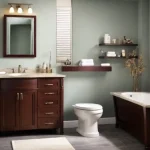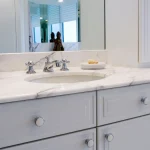So, you’ve decided it’s time to upgrade your bathroom and you’re eyeing that perfect vanity to fit snugly between two walls. Great choice! Installing a vanity between two walls can be a fantastic way to maximize your bathroom space and add a touch of style. But where do you start?
How do you ensure it fits perfectly and functions well? Don’t worry—I’m here to guide you through the process, step by step.
Whether you’re a seasoned DIYer or a first-time remodeler, you’ll find practical tips, helpful advice, and real-world examples to make your vanity installation a breeze.
So let’s dive into the planning phase and get you on your way to a beautifully fitted bathroom vanity!
Planning Your Vanity Installation
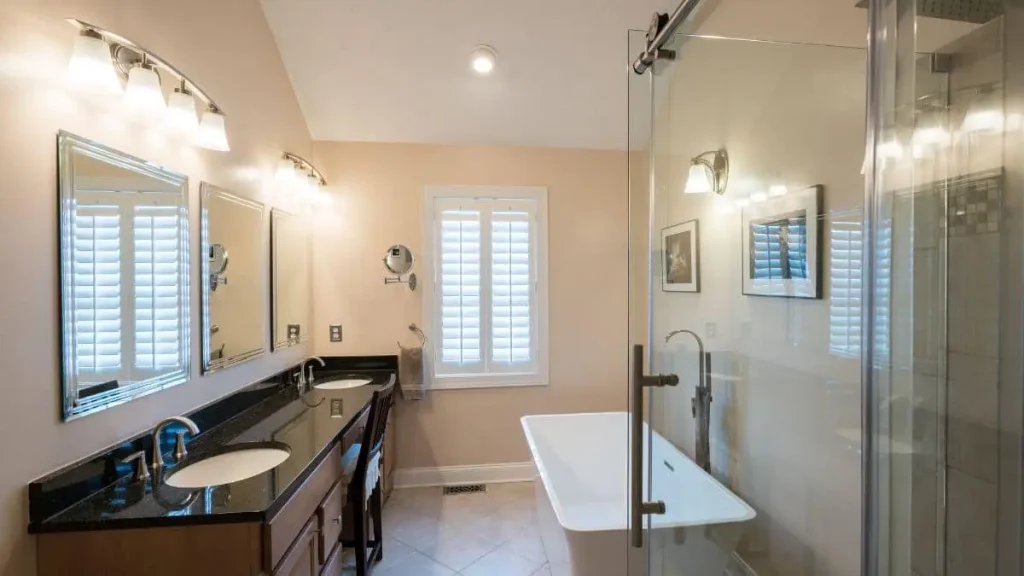
Determine Vanity Size and Style
Before diving into installation, it’s crucial to determine the right size and style of your vanity. This is where the magic starts! First, measure the space between your two walls. Use a tape measure to get the exact width, height, and depth you have available. This will help you choose a vanity that fits perfectly without crowding your bathroom.
Think about how you use your bathroom and what you need from your vanity. Do you need extra storage? Prefer a sleek, modern look?
Or maybe a traditional style fits your decor better? There are vanities in various styles—single or double sinks, with or without storage, and different finishes. Selecting a style that complements your bathroom’s overall design will make a huge difference in both aesthetics and functionality.
Design Considerations
Once you’ve nailed down the size and style, it’s time to think about design considerations. You’ll need to plan for the plumbing and electrical needs. Check where your water supply lines and drain pipes are located, as these will need to align with the vanity’s sink and plumbing fixtures. If you’re installing a light fixture above the vanity, consider how it will be positioned and connected.
Remember to think about the overall bathroom design. The vanity should not only fit physically but also blend harmoniously with your bathroom’s decor.
For example, if you have a modern bathroom with sleek lines and minimal decor, a contemporary vanity with clean lines and a glossy finish would work well. On the other hand, if your bathroom has a more traditional style, a classic vanity with ornate details might be a better choice.
Choosing the right size and style, and carefully considering the design elements, will ensure that your vanity fits seamlessly between two walls and enhances your bathroom’s overall look.
Tools and Materials Needed
Essential Tools
Before you start fitting your vanity between two bathroom walls, gather the following tools to make the job easier and ensure a smooth installation:
- Tape Measure: To measure the space and dimensions of your vanity accurately.
- Level: To ensure your vanity is perfectly level once installed. This helps prevent any issues with alignment and ensures that doors and drawers function smoothly.
- Drill: For making holes in the wall and securing screws and anchors.
- Screwdriver: To tighten screws and make adjustments.
- Stud Finder: To locate wall studs for secure mounting.
Having these tools on hand will streamline your installation process and help you achieve professional results.
Materials Required
You’ll also need the right materials to complete the installation:
- Vanity Unit: The centerpiece of your project. Make sure it matches the size and style you’ve planned for.
- Wall Anchors and Screws: To securely attach the vanity to the wall. The anchors are essential for holding screws in drywall and ensuring a sturdy fit.
- Caulk and Sealant: To seal gaps between the vanity and the wall, and around sink fixtures to prevent leaks.
- Plumbing Supplies: Pipes, fittings, and connectors for the water supply and drain lines. These should match the existing plumbing in your bathroom.
Gathering these materials before you begin will help you stay organized and keep the project moving smoothly.
Measuring and Preparing the Space
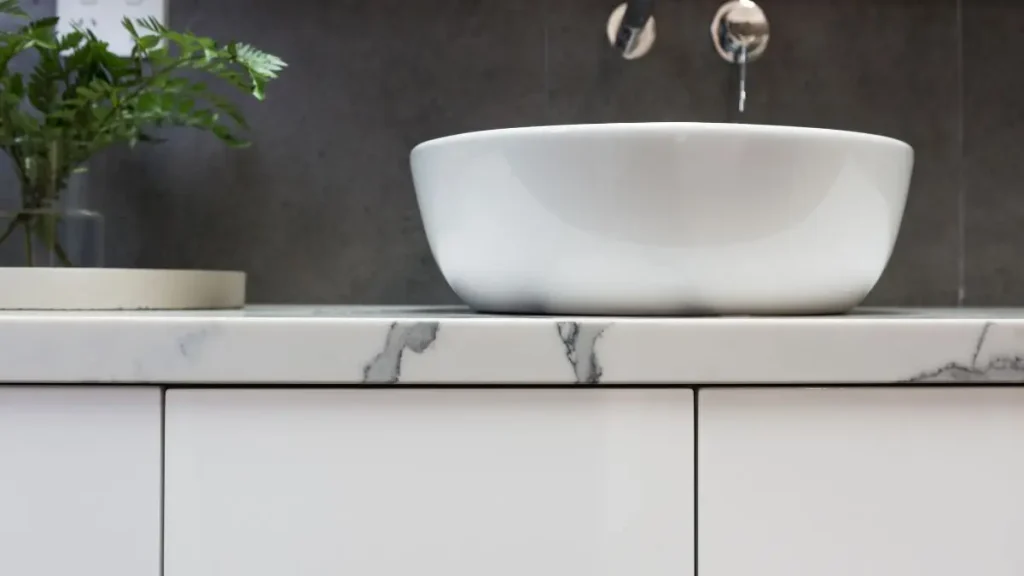
Accurate Measurements
Accurate measurements are crucial for a successful vanity installation. Here’s how to get it right:
- Measure Wall Space: Use your tape measure to determine the width and height of the space between the two walls. Check for any obstructions like electrical outlets or light switches that might affect where you place the vanity.
- Measure the Vanity: Ensure that your chosen vanity fits within the measured space. Double-check the width, height, and depth to avoid surprises during installation.
It’s also a good idea to measure the distance from the floor to any plumbing fixtures to ensure they align with the vanity’s sink and drain.
Preparing the Wall
With your measurements in hand, it’s time to prepare the wall for installation:
- Find and Mark Studs: Use a stud finder to locate the wall studs. Mark their positions with a pencil. These studs will provide the necessary support for anchoring your vanity securely.
- Check for Level Surfaces: Ensure the wall surface is level and even. If it’s not, you may need to use shims to correct any uneven areas before mounting the vanity.
Preparing the wall properly will ensure a solid and stable installation, preventing future issues with the vanity’s alignment or stability.
Installing the Vanity
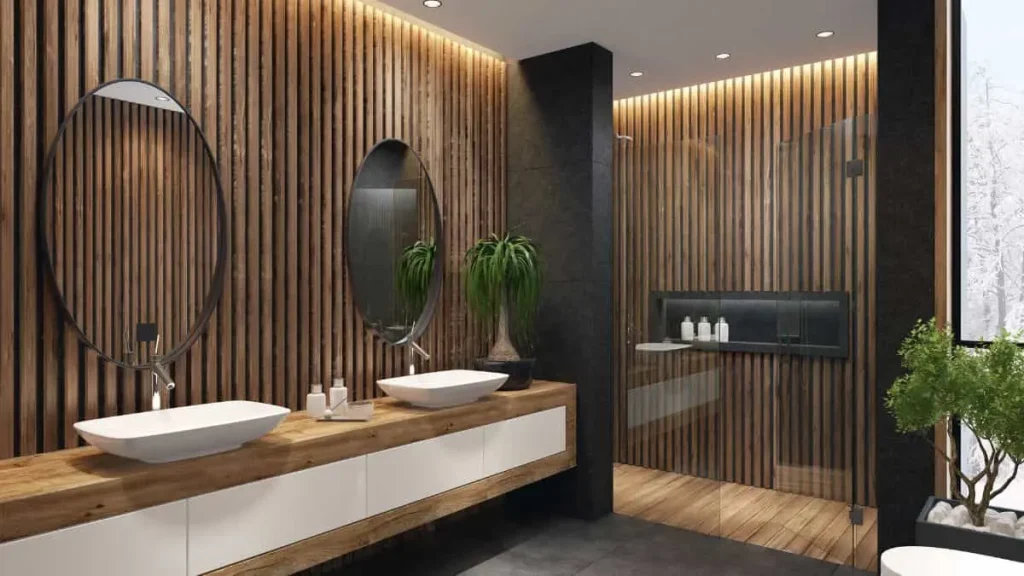
Mounting the Vanity
Now that you’ve measured and prepared your space, it’s time to get your hands dirty and install the vanity:
- Secure the Vanity to the Wall: Position the vanity between the two walls, aligning it with the marks you made for the wall studs. Use a level to make sure the vanity is perfectly horizontal. Drill pilot holes into the studs where you marked earlier.
- Attach Wall Anchors and Screws: Insert wall anchors into the pilot holes if needed (especially for drywall). Then, secure the vanity to the wall using screws. Ensure that the screws are tight but be careful not to overtighten and damage the vanity or the wall.
It’s important to have someone help you hold the vanity in place while you secure it to ensure it stays aligned and doesn’t shift.
Connecting Plumbing
With the vanity mounted, the next step is to connect the plumbing:
- Connect Water Supply Lines: Attach the water supply lines to the faucet. Make sure to use plumber’s tape on the threads to ensure a tight, leak-free connection. Connect the supply lines to the existing plumbing fixtures in the wall.
- Install the Drain: Connect the drain assembly from the sink to the drain pipe in the wall. Ensure all connections are secure and properly aligned to avoid leaks.
Turn on the water supply and check for any leaks around the connections. Tighten any loose fittings and make adjustments as needed.
Recommended: Why Extend Your Vanity Top Over the Toilet
Addressing Potential Challenges
Common Installation Issues
Even with careful planning, you might encounter some common issues during installation. Here’s how to tackle them:
- Uneven Walls: If your walls are not perfectly straight or level, you might need to use shims to create a level surface for the vanity. Place shims behind the vanity where it meets the wall and secure them in place.
- Plumbing Complications: Sometimes, existing plumbing might not align perfectly with your new vanity. You might need to adjust or replace pipes or fittings to ensure a proper connection.
Solutions and Tips
- Handling Uneven Surfaces: If your wall isn’t level, shimming the vanity will help. You can also use a self-leveling compound on the wall surface to create a more even area for mounting.
- Troubleshooting Plumbing Issues: If you encounter leaks, double-check all connections. Ensure that fittings are tightened properly and that plumber’s tape is used where necessary. If you’re unsure, consider calling a professional plumber to make any adjustments.
Taking these steps will help you resolve common challenges and ensure a smooth installation process for your vanity between two bathroom walls.
Final Touches and Design Ideas
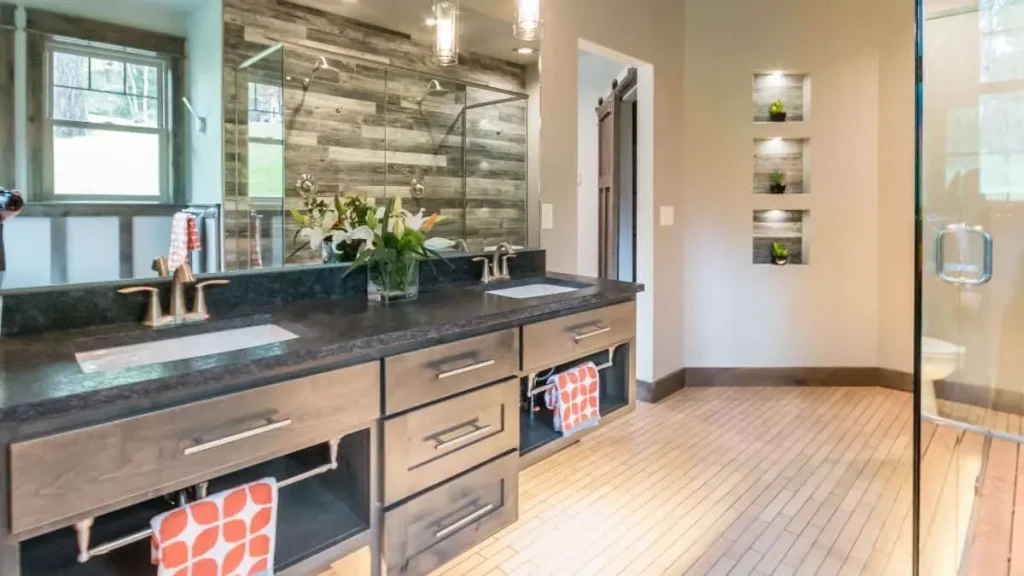
Finishing Touches
With your vanity securely installed and plumbing connected, it’s time to add the finishing touches to ensure everything looks and functions perfectly:
- Apply Caulk and Sealant: Use caulk to seal any gaps between the vanity and the wall. This helps prevent water from seeping into these spaces and causing damage. Apply sealant around the sink and faucet to ensure a watertight fit. Smooth out the caulk with a caulk smoothing tool or your finger for a clean finish.
- Install Hardware and Accessories: Attach any handles or knobs to the vanity doors and drawers. If your vanity includes a countertop, make sure it is securely attached and sealed around the edges. Check that all components are properly aligned and functioning.
These final touches not only improve the functionality of your vanity but also give it a polished, professional appearance.
Design Ideas
Now that your vanity is installed, think about how you can enhance its look and integrate it into your bathroom’s design:
- Backsplash: Adding a backsplash behind your vanity can protect your wall from splashes and spills while adding a stylish touch. Choose a backsplash that complements your vanity and bathroom decor—options include tile, glass, or even peel-and-stick designs.
- Mirrors: A well-chosen mirror can complement your vanity and enhance the overall look of your bathroom. Consider a mirror with a frame that matches or contrasts with your vanity for a cohesive or striking effect. Full-length mirrors or mirrored cabinets can also add functionality and style.
- Lighting: Good lighting is crucial for both aesthetics and functionality. Install a stylish light fixture above or beside the vanity to provide ample light for tasks. Wall sconces or pendant lights can add a touch of elegance and enhance the vanity’s visual appeal.
- Decorative Accessories: Personalize your vanity area with decorative items like soap dispensers, trays, or plants. Choose accessories that match your bathroom’s theme and add a touch of personality to the space.
Incorporating these design ideas will help you create a beautiful and functional bathroom that reflects your style and maximizes the use of your new vanity between two walls.
Conclusion
Congratulations on fitting your vanity between two bathroom walls! With the steps outlined in this guide, you’ve not only achieved a perfect installation but also created a functional and stylish focal point for your bathroom.
Carefully planning, measuring accurately, and addressing any challenges along the way, you’ve ensured that your new vanity fits seamlessly into your space and enhances your bathroom’s design. Adding those final touches, from caulking to stylish accessories, will give your vanity area a polished and personalized look.
Enjoy the benefits of your newly upgraded bathroom, and take pride in the fact that you’ve accomplished a significant home improvement project. Whether you’re admiring the enhanced functionality or the stylish appearance, your new vanity is sure to be a highlight of your bathroom for years to come.


